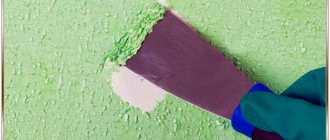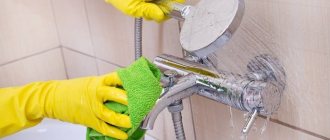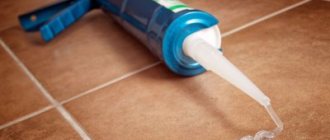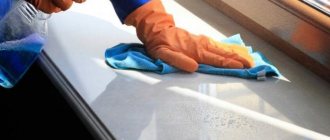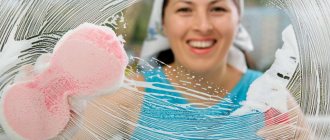I think this is familiar to most of us. Hard water and soap make the surface of ceramic tiles or glass dull and unsightly. Of course, there are plenty of products that promise to get rid of this plaque plaguing your bathroom, but most of them contain some pretty harsh chemicals. In addition, soap scum returns over time.
I'll tell you how to get rid of soap scum without using a gas mask when cleaning a shower stall or bathroom. This recipe will make your walls flawless.
By the way, the materials that will be used may already be at home.
Let's start!
How to clean different bathtubs
- Enameled cast iron baths. They should not be rubbed with steel wool or hard sponges. This leaves scratches and thins the enamel layer. Also, for cleaning you should not use aggressive products with a high chlorine content.
- Enameled steel baths. When washing, do not turn on too hot water. The enamel can crack even on a new bathtub due to sudden temperature changes. As in the case of a cast-iron bathtub, hard and metal sponges are prohibited.
- Acrylic baths. You need to wash it carefully, because even medium-hard sponges can leave unsightly streaks on such a bathtub. Use only soft sponges and special cleaning products, preferably gels or pastes. Do not use abrasive substances, washing powders, emulsions with alcohol, acetone, gasoline, or chlorine. A solution of soda and vinegar can be applied extremely rarely and only to particularly severe stains. In other cases, it is better to replace soda with lemon juice.
How to get rid of plaque on bathroom tiles
You will need items and materials that are found in every home. YOU will need to use a soap solution or any other non-aggressive medium. The use of abrasive substances is undesirable, because the latter can damage the tile surface. You will also need an aggressive medium in the form of vinegar, ammonia or soda. The choice depends on the cleaning method you prefer. Before you start cleaning tiles, it is recommended to wear a mask and gloves. You will also need a stiff toothbrush, a soft-textured sponge and a microfiber cloth. If we talk about preventative care, then it is worth washing the tiles once a week, using a soap solution. Then take a sponge pre-moistened in ammonia solution (1:1) or vinegar and wipe the tile. Thanks to this, there will be no streaks left on the tiles.
If you follow this rule, the tiles will not fade and will be clean. This procedure takes no more than 30 minutes of your time, and the result is worth the candle.
How to clean a bathtub from limescale
Hard water contains large amounts of magnesium and calcium salts. When they settle, a coating appears on the plumbing fixtures, which is more difficult to get rid of than soap.
Method 1. Vinegar-soda solution
- Mix ½ cup baking soda, ½ cup water and ¼ cup vinegar. If you are going to clean an acrylic bathtub, replace the baking soda with lemon juice.
- Apply the solution to the bath and leave for a while.
- Scrub the surface with a sponge and rinse off the vinegar solution with water.
Method 2. Soda + lemon solution
- Mix baking soda with water to form a paste.
- Apply to the bath and leave for a while.
- Add citric acid to water in a 1:1 ratio.
- Apply the solution to the baking soda and wipe with a sponge.
- Rinse the bathtub with water.
Vinegar
Undiluted white vinegar is ideal for cleaning stainless steel and chrome plated surfaces. It is enough to wipe the surface with it, leave it for 1–2 hours, and then rinse with clean water and wipe dry with a soft cloth. If the stain does not disappear, the treatment can be repeated. The shower head can be immersed in a bag of vinegar for 1-2 hours, then run water through it and rinse.
How to clean a bathtub from rust
Rusty streaks in the bathtub are the result of bad pipes or damaged enamel. In this case, the best way to forget about the problem is to eliminate its cause. But there are also several home recipes.
Method 1. Ammonia + hydrogen peroxide
- Pour 100 ml of ammonia and 50 ml of hydrogen peroxide into a glass container. Mix well.
- Using a cloth, apply the solution to the problem area.
- Rinse off with water after 10–15 minutes.
Method 2. Lemon juice
- Squeeze some lemon juice onto the rust stain.
- Leave on for 10-15 minutes and rinse with water.
Method 3. Soda
- Add water to the baking soda until you get a paste-like consistency.
- Apply the resulting paste to the rust stains with a sponge.
- Rub and rinse with water.
Stage 2: Method two
Oddly enough, you will need cooking spray for this method. If you don't know what it is, then I'll tell you. A cooking spray is an aerosol can containing a mixture of various oils under pressure, which is offered to us instead of the traditional oils that we use for cooking (frying) foods. This spray is very convenient for lubricating frying surfaces: grates, baking sheets, etc., etc. Personally, I have ordered PAM cooking spray from Amazon several times.
So, if you suddenly happen to have such a spray on hand)) (I recommend ordering it for testing). Shake the can well and lightly spray the spray onto the surface to be cleaned from a distance of approximately 15 cm. Wait 5-10 minutes (I don’t recommend leaving it longer, otherwise it will be difficult to remove) and wash off with plain warm or soapy water, depending on how much you need to wash off, you can add dishwashing detergent.
Why does this work? The long list of oils in cooking spray helps dissolve soap and limescale deposits without damaging the surface being cleaned.
How to use household chemicals
If you can’t get rid of dirt with home remedies, use cleaning powders and gels.
- Read the composition and consider the type of bath.
- It is better to use environmentally friendly substances, but they are more expensive.
- Follow the manufacturer's instructions. For example, sometimes the solution needs to be washed off immediately, sometimes it needs to be left for a while to make the bath clean.
- Some products have a strong, unpleasant odor. This means that to use them, your bathroom must have good ventilation.
- Never clean a bathtub without gloves.
Stage 1: Method One
For this method, you will need cloths that are used for drying clothes in a dryer. Wipes will work even if you have already used them a couple of times when drying. It is quite difficult to buy them from us because... Dryers are not popular. A friend from America brought it to me. I saw Lenor and some other Japanese ones on sale. In general, I highly recommend (if space allows) a dryer; after using these napkins, the laundry does not need ironing and has a pleasant aroma. I got distracted, let’s return to our method...
You just need to wet the wipes with tap water, squeeze out the excess water, and you can start cleaning. With a little effort, you will see how the surface is cleaned and soap deposits are removed. If necessary, rinse the napkin and continue cleaning. Why does this work? Who knows... but it works just fine!
Mold control
Cleaning a plastic or glass shower stall is not difficult, but dealing with fungus is much more difficult. If you notice black spots in the corners, in seams and hard-to-reach places, immediately use special antifungal compounds. Use them according to the instructions. An alternative could be a mixture of baking soda, ammonia and vinegar.
Mix half a glass of vinegar and ammonia solution, add 0.25 cup of soda. Clean problem areas with the prepared mixture. They can be lightly rubbed with a toothbrush. Leave it on for a while and then wash it off.
Fighting mold in the bathroom - video:
Clean your shower stall in a timely manner, wash away soap stains and wipe the walls dry, then it will be much easier to keep it clean.
How to quickly clean at home?
The shower stall consists of several parts made of different materials, so an integrated approach is used to clean contaminants. This takes into account the material of manufacture, as well as the presence of a hydromassage panel and other devices.
For cleaning use:
- a synthetic sponge or a special brush for washing;
- glass scraper with rubber coating;
- microfiber cloth;
- cleaning products in the form of sprays, pastes and creams.
For cleaning it is not recommended to use :
- sponge made of metal threads;
- sharp scraper;
- cleaning products with ammonia and acetone;
- abrasive powders.
If daily care is observed, general cleaning can be done once a month . Cleaning usually starts with walls and doors, then washes faucets, handles and hinges.
At the very last stage, the tray is cleaned. Some shower stalls have a base that is covered with a special screen - it is wiped last.
Faucets, watering cans, hoses and fixtures also require maintenance. They are washed to remove limescale, stains and rust; after washing, all surfaces are wiped and polished.
Getting rid of limescale
Limescale stains on surfaces are formed due to poor-quality hard water. To prevent their occurrence, it is best to use a reverse osmosis filter. It traps salt particles and other impurities that cause plaque.
But not everyone can afford such a device. Therefore, you have to use various cleaning products. Paste-like substances, as well as detergent compositions in the form of cream or spray, will come to the aid of housewives.
Shower cabins are usually equipped with acrylic trays .
Which in their composition and production methods are no different from ordinary acrylic bathtubs.
In order to find out the most complete information on how to clean the acrylic surfaces of booths from limescale, yellow stains and rust , we recommend that you visit our special article .
Removing fungus from bathroom tiles
In the restroom, conditions for the development of fungus are very favorable. Therefore, you may notice black or green spots on the tiles, in the seams, near the sides of the bathtub or tray. This is not only an aesthetic drawback: mold spores are fraught with allergies, asthma, and dermatosis.
A few precautions:
There are special antiseptics on the market that effectively deal with mold. Some people prefer proven folk remedies. In any case, work with solutions wearing gloves and a respirator.
The first spots of mold can be removed with a construction knife, and the area can be treated with an antiseptic or plumbing product. To get rid of a small lesion, use the following home remedies:
When working with alcohol, do not close yourself indoors. Vapors may cause poisoning. Ammonia removes mold only from the surface of the tile. For seams you will have to choose a different method.
Also remember that it is contraindicated to clean glossy tiles with a hard brush or abrasives. Otherwise, small scratches will appear on it, it will stop shining and become dull. To make the job easier, you can brush between the seams, removing mold, and only then begin processing.
Large areas of fungus cannot be removed using improvised means. They use aggressive household chemicals. You may have to process the room several times. Izocid, SikaGard and other antifungal products are popular.
You need to work with the products only according to the instructions provided. The bathroom is a high-humidity area, so plaque or mold often appears on the tiles. It is much easier to regularly monitor cleanliness than to buy special products later. If you don’t want to spend money on household chemicals, try folk recipes with vinegar, ammonia or soda.
Acrylic bathtubs
Acrylic bathtubs are by far the most common. However, despite this, they are not without drawbacks. For example, their coating is very sensitive to strong chemicals. It is for this reason that it is highly recommended not to use products containing:
- Alcohols
- Acids
- Ammonia
- Acetone
- Chlorine
- Formaldehyde
- Alkali
Also, to clean acrylic bathtubs, you should not use washing powder, as it will cause the bathtub to take on a dull tint.
Care for acrylic bathtubs should be done using liquid soap or dishwashing liquid, as well as a soft sponge or paper towels.
The best way to clean acrylic is to maintain your bathroom regularly. After each water procedure, you should wipe the bath with a damp cloth or sponge, thereby removing fresh deposits.
How to clean a shower stall: an overview of possible options
When choosing a detergent, you should take into account the type of contamination and the type of material for which it will be used. The shower cabin has plastic and glass elements, chrome parts, and the tray can be made of acrylic or enameled steel.
Store products
In stores, the choice of cleaning products for plumbing fixtures and showers is huge. It is better to buy a spray, gel, cream or liquid. Will cope well with dirt:
- “Cif” is a special composition with a creamy consistency that copes well with lime, soap scum and rust, has a pleasant smell and has whitening properties.
- "Mr. Muscle" is a spray that will help restore transparency and shine to glass doors.
- “Acrilan” is a liquid that is applied with a spray bottle and can be used to combat severe dirt and mold.
- Tilex is a product that not only copes well with grease stains from soap, but also has antibacterial properties, which is very important when caring for a shower stall.
The list of household chemicals that are suitable for use at home can be continued for a long time. To verify this, just visit the corresponding department in any store. When choosing a product, study the composition and purpose, since some gels and creams based on ammonia, alcohol and other aggressive substances are incompatible with certain materials.
Note! Do not use various powders and liquid compositions containing abrasive particles to clean the shower stall. The abrasive leaves scratches into which dirt can easily get clogged, and it will become more and more difficult to clean it each time.
Another tool for cleaning the shower stall - video:
If you think that household chemicals are harmful to humans, you can use folk remedies. Experienced housewives usually have several recipes that help cope with even complex and neglected stains.
Table vinegar
Vinegar helps effectively fight limescale. It easily destroys deposits of mineral salts contained in water, returns shine to chrome elements and destroys most bacteria, and also gets rid of soap scum. Use it like this:
- Prepare a solution by mixing one glass of vinegar with two glasses of water.
- Using a spray bottle, spray the solution onto the shower stall, paying special attention to contaminated areas.
- Leave for 10-15 minutes and then rinse with clean water.
If there are heavy lime deposits on your faucet or whirlpool head, vinegar will also help get rid of them. Dilute it with water in a 1:1 ratio and generously moisten a rag or napkin in the prepared solution. Place it on problem areas and leave for several hours or overnight, then rinse with clean water. If the part unscrews easily, it can be removed and dipped in a vinegar solution.
Note! Vinegar is an aggressive substance, so be sure to use rubber gloves for protection when working with it.
Lemon acid
Housewives often wash the shower stall with citric acid, because this is one of the simplest, most effective, inexpensive and safe methods. The principle of using a food additive is very similar to vinegar:
- Dissolve a 100-gram bag of citric acid in 0.5 liters of warm water.
- Spray the prepared mixture onto contaminated surfaces using a spray bottle.
- After 10–15 minutes, you can rinse with clean water.
To give chrome elements a special shine, additionally wipe them with a slice of fresh lemon.
You can also use citric acid in combination with baking soda. In a glass of warm water, dilute a small bag of citric acid (20–30 g) and 20 g. soda Use the prepared solution according to the principle described above.
Vodka or alcohol
Rubbing alcohol or vodka will not only quickly remove dirt and stains, but will also additionally disinfect the shower stall. To do this, mix a spoonful of strong drink with two spoons of clean water. Dampen a soft rag or napkin in the prepared mixture and wipe problem areas. Then wipe dry with a dry cloth. To enhance the effect, add a spoonful of vinegar.
Toothpaste or powder
If you want to restore the cleanliness of an acrylic or enamel tray, use toothpaste. Apply it in a thin layer to the surface to be treated. After a while, you need to remove the paste with a sponge and wash the walls with clean water.
An alternative could be tooth powder, which copes even better with various types of stains. Sprinkle it on problem areas and lightly rub with a damp cloth, then rinse. Tooth powder has a mild effect, so it is not capable of damaging acrylic or enamel.
Ammonia
If you want your glass to sparkle clean, use ammonia:
- Dilute a tablespoon of the substance in a liter of cold water.
- Soak a soft cloth in the solution.
- Wipe glass surfaces with it.
The solution can also be used to clean walls. If you add a little glycerin to the mixture, it will not only cope with contaminants of various origins, but also leave an invisible film on the surface that will repel water.
Note! When working with ammonia, a strong unpleasant odor will appear in the room, so before starting work, open the window.
Hydrogen peroxide
Another remedy from your home medicine cabinet can also get rid of limescale – hydrogen peroxide. It will perfectly and in just a few minutes soften, or even completely dissolve, deposits of mineral salts on the walls, mixer and other parts. Simply soak a soft cloth in peroxide and wipe the problem areas with it. If the plaque cannot be removed immediately, a napkin soaked in an antiseptic can be left on for a while.
Causes of bath contamination
Any bathtub, regardless of its material (metal, cast iron, acrylic or even marble), is prone to contamination due to its constant contact with water. Here are the main causes of pollution:
- Light touch. This is pollution that occurs as a result of daily bathing or showering. It consists of skin particles, its secretions and soap solution. This contamination is removed quite simply - just a sponge and warm water.
- Soap scum. Over time, the products that we use for personal hygiene: soap, shampoo, shower gel, conditioner - eat into the enamel, and getting rid of them is quite problematic.
- Hard water. This phenomenon, of course, depends on the region of residence. If there is a high concentration of salts in tap water, then after some time a yellowish-white crumbling coating can be found on the surface of the bathtub, which can only be removed with an acid-containing cleaning agent.
- Rust. It appears due to increased levels of iron in tap water.
- Bath age. With prolonged use, due to the natural abrasion of the glossy surface to a rough state, it becomes easier for rust to eat into roughness and small cracks.
- Accidental contamination. These include an accidentally dropped drop of paint during repairs or other coloring material.
Cleaning off rust stains and yellow deposits
Dangerous microorganisms also attack the toilet and sink. In addition, plumbing inevitably suffers from water quality. As a result, an indelible coating appears on the surface, the causes of which are rust, limestone deposits, and urinary stones. Trying to cope with problems with the help of abrasives, you can harm the coating and start the process of its gradual destruction. The rough surface of the bowl will trap even more dirt. How to remove plaque and stubborn stains? HG Universal cleaner for the bathroom and toilet will cope with any, even seemingly insoluble, problems of the toilet or sink. Rust stains, limescale and stubborn dirt have no chance of survival! After cleaning with HG, the surfaces will sparkle with snow-white purity!
How to remove limescale
This very plaque appears unnoticed and accumulates quickly. After a very short time, he will be able to ruin the mood of everyone taking a shower.
Special products will also help get rid of limescale.
They say that window or dishwashing liquid does a good job of removing stains, but it’s hard to believe.
Soda
Among the folk remedies, baking soda with vinegar or lemon will help perfectly. Lemon is preferable as it will leave behind a fresh citrus aroma.
Soda
If you have soda in the depths of your refrigerator, you can try using that too. The action goes something like this.
- The surface is generously moistened with Cola or Sprite (our lemonades cannot stand comparison).
- Leave for about 15 minutes.
- Wash off with plenty of water. You will need more liquid to remove all the sugar.
Store products
Of the special products, “Mister Muscle”, “Sif”, “Sanelit” cope well with limescale deposits. They are quite gentle.
ADVICE! Before purchasing, it is better to check whether the product is suitable for all surfaces of your plumbing equipment.
Melamine sponge
Melamine sponges have proven themselves well. Manufacturers promise that they will cope with soap stains, limescale, yellowness, rust and even mold. And they are suitable for all surfaces.
Removing fungus and mold
Even the most modern bathroom is not immune to mold. This may be due to improper ventilation of the room, constant dampness or a leaking faucet. A favorite place for mold to grow is between the bathtub and the wall. In addition to aesthetic discomfort, mold can have a negative impact on the health of people living in the house. In this regard, if a fungus is detected, it is necessary to immediately begin its elimination. Here are the main ways to eliminate mold in the bathroom:
- Prevention. Wash off plaque regularly with laundry soap once a week.
- Treat the affected areas of the surface with copper sulfate, which can be easily purchased at any nearby hardware store.
Important! It is necessary to work with copper sulfate using a brush and strictly wearing rubber gloves.
- Apply bleach or bleach (chlorine-based) to the affected area and then rinse with plenty of water.
The most radical method is to dismantle the existing corner between the bathtub and the wall, completely remove the old sealant, treat the fungal colony using the above methods, and then install a new corner. Also worth noting are such household chemicals as special antiseptics for fungus and mold. They are quite effective, but at the same time harmful to the respiratory system. However, the best way to get rid of mold is to prevent it from occurring. This can be achieved only by completely eliminating moisture in the room by installing supply and exhaust ventilation.
Removing dirt and soap stains
According to scientists, shower stalls contain millions of dangerous bacteria that can cause serious illness in humans. They enter the house with tap water, accumulate in the tap or shower head, and then enter our body during daily hygiene procedures. Their reproduction is facilitated by the warm, moist environment of the shower stall, the remnants of cosmetics and dirt that we wash off. A high-quality bathroom cleaning product will help you fight uninvited guests; it will not only remove all stains and yellow deposits from the surface without damaging it, but will also provide long-term protection. HG Bathroom Cleaner is the perfect weapon to fight dirt and bacteria! It will remove soap and shampoo residues, as well as light limescale deposits, but most importantly, it will deal with dangerous microorganisms that have taken over your property! HG will keep your shower cabin clean and shiny for a long time!
